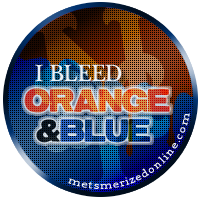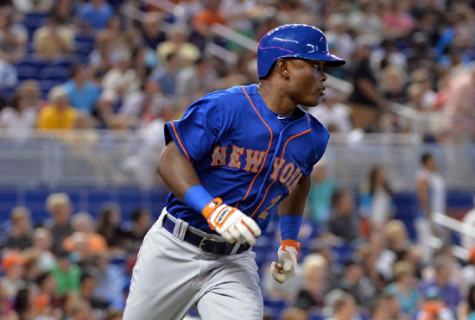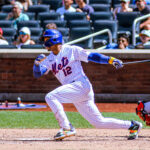
Before Daniel Murphy blasted that epic home run in the Mets 3-1 victory over the Miami Marlins, there were many killing Murphy and some were even calling for him to be replaced by Triple-A second baseman who has been tearing it up in Las Vegas.
 Herrera, 21, has been a Top 100 prospect in baseball, ranking as high as No. 46 on MLB.com to as low as No. 82 on Baseball Prospectus. But just how good is the Mets’ young second baseman? Can he become an All-Star, as Keith Law predicted, or is he more destined to be a solid starter? Most importantly, how much better can he be than Daniel Murphy?
Herrera, 21, has been a Top 100 prospect in baseball, ranking as high as No. 46 on MLB.com to as low as No. 82 on Baseball Prospectus. But just how good is the Mets’ young second baseman? Can he become an All-Star, as Keith Law predicted, or is he more destined to be a solid starter? Most importantly, how much better can he be than Daniel Murphy?
Offensively, Dilson Herrera has the bat-speed to make scouts drool. His lightning quick hands should allow him to hit for a good batting average accompanied by solid-average power at the major league level. In a cup of coffee last season with the Mets, he showcased that potential, posting a .710 OPS and three home runs in just 18 ballgames.
So far in his minor league career, Herrera is striking out in almost 20 percent of his plate appearances while walking at an 8 percent rate. There’s value in his aggressive, slap-heavy approach, plus Herrera has improved his discipline in Vegas thus far. Ironically, in comparison to Murphy, Herrera’s power and patience seems somewhat equivalent.
Dilson couples strong offensive tools with his strong minor league numbers. Across three levels last year, he mashed his way to a .323 batting average and a .858 OPS. He’s continued his hot hitting this year at Triple-A Vegas, batting a scorching .371 and absolutely murdering lefties (1.300 OPS).
Of course, we have to put an asterisk next to any statistic in the hitting haven of Las Vegas, but with a career .301 average in more than 1,600 at-bats, Herrera has a long track record of minor league success. Plus, he’s still managed to bat .311 on the road this year.
But while Herrera appears major league ready on the offensive side of the diamond, and he does add some speed (23 steals in 2014), his defense leaves a lot to be desired out of a middle infielder.
Baseball Prospectus reports that South Atlantic managers felt the youngster’s actions were “stiff” in the field, and Minor League Ball’s John Sickels concurred with those concerns last August. Still, the general consensus is that Herrera’s bat justifies his defensive limitations. However, I am not so sure that is the case.
Consider this clip taken from Matz’ no-hit bid last Friday night. (Courtesy MiLB.TV)
Former Mets prospect Nick Evan bounces a routine ball to second, but Herrera looks far from smooth on the play. First, instead of attacking the ball, he sits back on his heels and lets the ball play him, forcing an awkward jump into the air. He then makes an indecisive move towards second base before showing off an incredibly weak sidearm throw to first.
Here’s another grounder to second during the same game. Herrera does not commit any egregious mistake this time, but he demonstrates that he is not entirely comfortable at second base. He makes a nice backhand stab, but then showcases more awkwardness with bad footwork and a double-clutch. He finishes off the play with the same weak sidearm toss we saw before.
Of course Bobby Ojeda, while still with SNY, pointed out these same defensive limitations after Herrera was promoted to the big-league team and committed three errors in just 81 chances during his brief cup of coffee. Small sample size, yes, but consistent with what scouts, observers, and managers have previously said about Herrera over the last three seasons.
For those holding out hope that Dilson can play shortstop and Flores can move to second, that has to be ruled out as a long-term option at this point
Herrera is by no means a terrible defensive second baseman, but I have serious concerns regarding his footwork, arm strength, and overall level of comfort at second base. He still has plenty of time to improve, but as he also committed 21 total errors last season, I have a hard time believing he’ll ever be more than adequate in the field.
In conclusion, I see many similarities between Murphy and Herrera. Tool-wise, both players have quick bats, a strong offensive skill-set but also a weak defensive profile. These similarities are reflected through minor league statistics as well.
Murphy and Herrera’s career minor league OPS only differs by 20 points, and Murphy’s minor league fielding percentage was actually 50 points better than Herrera’s. Murphy and Dilson can both handle second base to a degree, but it’s hard to argue that each player has the instincts and fluidity to ever become a solid infielder.
Dilson Herrera will be a good big league player, but expecting him to be a significant upgrade over Murphy is asking him to underwhelm. He might not commit the same mental mistakes as Daniel has this season, but considering the course of Murphy’s entire career, I would expect these two players to produce a similar career output.
Remember, that is not necessarily a bad thing: Murphy has produced 10.8 WAR in seven seasons with the Mets. Just temper your expectations for Dilson when he finally gets a chance at a starting role: he will be good, but only time will tell if he can be better than Murphy.
















